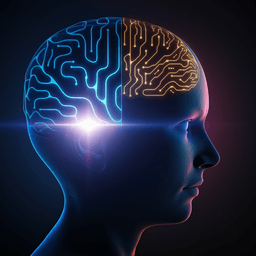
Psychology
Reducing racial ingroup biases in empathy and altruistic decision-making by shifting racial identification
S. Mei, Y. Deng, et al.
Using self-report, behavioral, and neuroimaging measures, this research showed that a mask training procedure that alters self-face perception can increase identification with another race, modulate medial prefrontal activity, amplify neural responses to other-race pain, and reduce own-race favoritism in altruistic decisions. This research was conducted by Shuting Mei, Yiwen Deng, Guo Zheng, and Shihui Han.
~3 min • Beginner • English
Introduction
The study investigates whether shifting an observer’s own racial identification can reduce racial ingroup biases in empathy and related prosocial behaviors. Prior work shows robust racial biases in empathy-related neural responses (e.g., ACC, IFC, SMA, AI, mPFC, TPJ) and in altruistic decisions, typically favoring one’s ingroup. The authors hypothesize that racial identification—a flexible component of self-concept distinct from racial identity—plays a key role in modulating empathic responses. By altering self-face perception through a mask training procedure (MTP) that embodies an other-race facial disguise, they test whether increased identification with another racial group reduces ingroup bias in empathy for pain and altruistic decision-making, and examine the neural mechanisms (especially mPFC) linking identification shift to empathy modulation.
Literature Review
The paper reviews extensive evidence of racial biases in cognition and affect, including own-race advantages in face perception and recognition, and stronger empathic neural responses to ingroup pain in ACC, IFC, SMA, AI, sensorimotor areas, mPFC, and TPJ across White, Black, and Asian samples. EEG studies show larger P2 amplitudes to pain expressions for own-race faces; fMRI shows greater BOLD responses to ingroup pain. The authors distinguish racial identification (self-concept of group membership) from racial identity (collective group features) and individual identification. Prior experimental manipulations (enfacement and body ownership illusions) can alter self-concept, somatosensory resonance, and implicit racial attitudes, suggesting identity fluidity, but direct evidence linking shifts in racial identification to reduced racial ingroup bias in empathy and altruism has been lacking. This work integrates self-report, behavioral, EEG, and fMRI to fill that gap.
Methodology
Design: A between-subjects design compared an other-race mask training procedure (MTP; test groups) with an own-race MTP (control groups). The MTP had four phases (~17–20 min total): (1) selection and wearing of a same-gender facial disguise; (2) visual-motor synchrony (looking in a mirror, moving to feel synchrony, imagining being the person in the disguise); (3) viewing each other wearing disguises to reinforce shared race attributes; (4) self-oriented pointing task generating visual-motor-tactile integration by touching locations (eyes, cheeks, ears, nose) on the worn disguise when cued. Measures were taken when participants were not wearing masks.
Participants: Multiple independent samples of young adults. Experiment 1: Chinese test group 1 (white disguise, N=40), test group 2 (Black disguise, N=39), White test group 3 (Asian disguise, N=36), Chinese control (Asian disguise, N=40). Experiment 2: Chinese test group 1 (white, N=47), test group 2 (Black, N=39), White test group 3 (Asian, N=36), Chinese control (Asian, N=48). Experiment 3: Chinese test (white, N=40) and control (Asian, N=40), same participants also in Experiment 5. Experiment 4: Chinese test (white disguise; EEG after MTP, N=30) and control (Asian disguise; N=30). Experiment 5: Chinese test (white disguise, N=40) and control (Asian disguise, N=40). Experiment 6: Chinese test (white disguise, N=40) and control (Asian disguise, N=40). Inclusion criteria included normal/corrected vision, no neuro/psych disorders.
Tasks and Measures:
- Experiment 1 (Self-report): Before/after MTP, 7-point Likert ratings of identification with original race and race of worn disguise.
- Experiment 2 (Implicit behavior): Racial face categorization task (200 ms faces, ISI 800–1400 ms), classify faces into two race categories; RTs analyzed with mixed-effects models.
- Experiment 3 (fMRI self-referential task): Trait adjective judgments on images of worn vs unselected disguises before/after MTP; block design fMRI; ROI mPFC (MNI −6/45/3) and whole-brain analyses.
- Experiment 4 (EEG empathy for pain): ERP responses (P2, 150–200 ms, frontocentral electrodes) to pain vs neutral expressions of Asian and White faces; race identification button press; single-trial mixed-effects regression.
- Experiment 5 (fMRI empathy videos): Video clips of Asian/White models receiving painful (syringe) or nonpainful (cotton bud) facial stimulations; race judgment; whole-brain contrasts (painful vs nonpainful), ROIs defining two networks: Network 1 (right IFC 56/28/6, right premotor 48/6/50, right insula 40/0/−16; affective sharing) and Network 2 (bilateral TPJ −64/−40/34 and 62/−28/34; right STS 50/−16/−8; perspective taking). MVPA in network 1 using SVM. DCM modeling connectivity between mPFC and right premotor/IFC/insula; Bayesian model selection.
- Experiment 6 (Altruistic decision-making): Choice to donate ¥10 to one of two morphed faces varying independently in race (Asian–White pixel proportion) and expression (Neutral–Pain pixel proportion). GLME with binomial link; regressors included race difference, expression difference, time (pre/post), group (test/control), interactions.
Data acquisition and analysis: fMRI on 3T Siemens (2 mm isotropic), standard preprocessing (slice timing, realignment, coregistration, normalization, smoothing), GLMs with motion regressors, cluster-level FWE correction. EEG with 64 channels, ICA-based artifact removal, mastoid re-reference, band-pass filtering, epoching, artifact rejection. Statistical analyses used mixed-effects models, ANOVAs with Greenhouse-Geisser corrections, post hoc tests with Bonferroni/FDR corrections.
Key Findings
- Experiment 1 (Self-report shift): Significant 3-way interaction of race × time × group (F(3,151)=22.08, P<0.001), indicating distinct post-MTP identification patterns. Test groups increased identification with worn other-race disguise and decreased identification with original race: Test1 (Chinese wearing White): other-race 3.85 vs 1.40, t=10.11, P<0.001; original 3.70 vs 6.53, t=−10.89, P<0.001. Test2 (Chinese wearing Black): other-race 3.51 vs 1.10, t=9.82, P<0.001; original 5.64 vs 6.62, t=−3.71, P<0.001. Test3 (White wearing Asian): other-race 3.86 vs 1.56, t=9.02, P<0.001; original 4.56 vs 6.25, t=−6.19, P<0.001. Control (Chinese wearing Asian): no significant changes (Asian 6.58 vs 6.28, P=0.25; White 1.15 vs 1.20, P=0.837). Between-group differences: Test1 vs Control F(1,78)=77.05, P<0.001 (ηp²=0.50); Test2 vs Control F(1,77)=33.80, P<0.001 (ηp²=0.31); Test3 vs Control F(1,74)=59.08, P<0.001 (ηp²=0.44).
- Experiment 2 (RT implicit shift): Significant 3-way interaction race × time × group (F(3,151)=6.79, P<0.001). The pre-MTP advantage for other-race vs own-race categorization speed diminished post-MTP in test groups, not in control. Group contrasts: Test1 vs Control b=27.04, P<0.001; Test2 vs Control b=50.14, P=0.007; Test3 vs Control b=26.55, P=0.011.
- Experiment 3 (mPFC self-referential): ROI mPFC showed mask × time interaction (F(1,79)=6.91, P=0.010); increased activity for worn disguise after vs before (−0.14 vs −0.30, t=4.96, P<0.001), not for unselected (−0.21 vs −0.27, t=1.72, P=0.089). Differential (after−before) increases for worn were larger in test vs control (mask × group interaction F(1,78)=6.72, P=0.011; 0.23 vs 0.10, t=2.14, P=0.036); no group difference for unselected (0.03 vs 0.10, P=0.275). Whole-brain confirmed mPFC activation in test group (−12/50/2, voxel P<0.001, cluster P<0.05 FWE).
- Experiment 4 (EEG P2 empathy): Significant interaction target race × expression × group (F(1,58)=4.07, P=0.044). Control: larger P2 to pain vs neutral for Asian faces (3.69 vs 2.64 μV, z=5.42, P<0.001), not White (4.11 vs 3.94 μV, z=0.86, P=0.388), indicating ingroup bias. Test: no racial difference (b=0.10, P=0.702); P2 increased to pain vs neutral for both Asian (3.43 vs 2.51 μV, z=4.70, P<0.001) and White faces (4.42 vs 3.61 μV, z=4.24, P<0.001), indicating reduced ingroup bias and enhanced responses to other-race pain.
- Experiment 5 (fMRI empathy networks): Before MTP, painful > nonpainful activated right premotor, bilateral IFC/insula, SMA, postcentral, IPC, medial/superior temporal cortices, TPJ, temporal pole, fusiform (voxel P<0.05 FWE). Pre-MTP ingroup bias: stronger responses to Asian vs White pain in bilateral IFC, right insula/premotor, STS, TPJ (voxel P<0.001, cluster P<0.05 FWE). Post-MTP, ROI analyses for White pain: Network 1 (right IFC, premotor, insula) showed higher contrast values in test vs control (main effect of group F(1,78)=6.91, P=0.010), consistent across ROIs (F=0.46, P=0.632). Network 2 (TPJ/STS) showed no group effects (Ps>0.364). MVPA decoding of White painful vs nonpainful was above chance in test (59.79%, t(39)=4.04, P<0.001, d=0.64, FDR corrected), not control (53.96%, t(39)=1.65, P=0.144). DCM: winning family model (mPFC→right premotor) with exceedance probability 94.59%; significant intrinsic connectivity mPFC→premotor (t(39)=2.87, P=0.007), not reverse (P=0.433). Painful inputs increased mPFC→premotor connectivity (t(39)=2.43, P=0.020) and decreased premotor→mPFC (t(39)=−2.08, P=0.044). Control had no winning model. Across experiments 3 and 5, mPFC modulation (worn vs unselected after vs before) correlated with right premotor responses to White pain post-MTP (r=0.35, P=0.027).
- Experiment 6 (Altruism): GLME showed positive effects of race (b=0.32, P<0.001; ingroup favoring Asian) and expression (b=1.19, P<0.001; pain increased donations). Significant group × time × race interaction (b=0.19, P=0.005). Race coefficient decreased after vs before in test (b=−0.11, P=0.021), not in control (b=0.07, P=0.101), indicating reduced ingroup favoritism in donations after other-race MTP.
Discussion
The findings demonstrate that shifting racial identification via short-term embodiment of an other-race face reduces racial ingroup biases in empathy and prosocial decisions. The MTP altered self-face perception, producing increased identification with the other race and decreased identification with the original race (self-report and RT). At the neural level, trait judgments on the worn disguise enhanced mPFC activity, especially in the other-race MTP, implicating self-referential processing of newly associated racial attributes. Empathic neural responses to other-race pain were elevated after identification shift: EEG showed elimination of P2 racial bias, and fMRI localized enhanced responses in affective sharing regions (right premotor/IFC/insula), with mPFC-to-premotor connectivity modulated by perceived pain. The correlation between mPFC modulation (identification shift) and premotor empathic activity supports a mechanistic link from self-concept updating to increased empathy for outgroup members. Behaviorally, reduced ingroup favoritism emerged in altruistic donations to faces parametrically varying in race and pain. Together, the results suggest racial identification as a causal, flexible psychological basis for empathic biases, and that short-term embodiment can generalize beyond specific targets to unfamiliar individuals.
Conclusion
This study introduces a multisensory mask training procedure that reliably shifts racial identification and shows, across self-report, behavioral, EEG, and fMRI measures, that such shifts reduce racial ingroup biases in empathy and altruistic decision-making. Neural evidence implicates the mPFC in representing updated self-related racial attributes and in modulating affective empathy networks (premotor/IFC/insula) for other-race pain. The approach suggests a promising, short-term route to attenuate racial biases in social emotion and behavior and offers a mechanistic account linking self-concept plasticity to empathic engagement. Future research should assess the durability of effects over longer timescales, extend to diverse ages and racial populations, disentangle contributions of the MTP’s embodied vs social-perceptual components, and evaluate translational potential and acceptability in real-world contexts.
Limitations
- Temporal scope: Effects were measured within hours post-MTP; longevity over days/weeks is unknown.
- Sample generalizability: Young Chinese and White participants only; other racial groups and age ranges were not tested.
- Intervention scope: The MTP is a laboratory tool to temporarily shift self-concept; it is not designed as a real-world intervention and may carry acceptability concerns across sociocultural contexts.
- Mechanistic specificity: Multiple MTP phases (visual-motor, visual-motor-tactile, social-perceptual exposure) were combined; the relative contributions of embodied vs social-perceptual experiences to identification shift were not isolated.
- Context sensitivity: Racial identification and race perception are influenced by social environments; how contextual factors modulate identification shifts was not directly examined.
- EEG timing constraints: EEG collected only post-MTP due to technical limitations, precluding within-subject temporal comparisons of ERP changes across the MTP.
Related Publications
Explore these studies to deepen your understanding of the subject.







